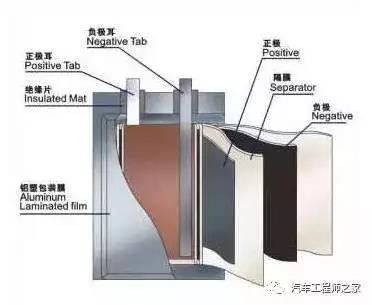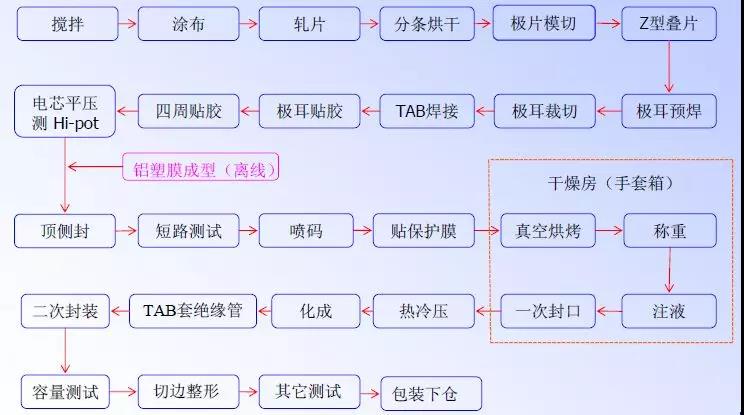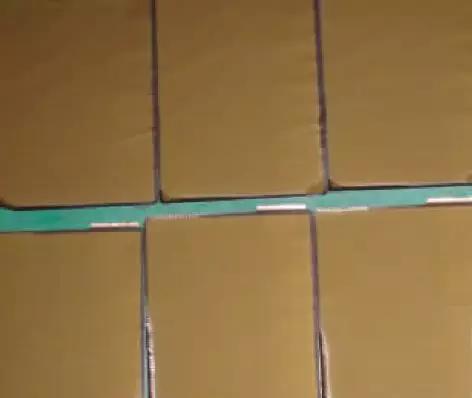With the continuous increase of energy density requirements, each manufacturer is trying to improve the parameters of their products, mainly along two half lines in the efforts: one is to speed up the research and development of positive electrode materials with high specific energy, the other is to increase the capacity of the battery monomer, reduce the proportion of auxiliary structures such as the shell in the monomer. The other half is to consider the transformation of soft-pack battery, which can be seen from the current mainstream battery factory to actively undertake national soft-pack battery research projects. Is the soft pack battery the most suitable power battery technology route? Today to sort out some soft pack battery content, together with a prediction of the power battery future technology route.
Basic structure of soft-pack battery

Pictures from the home of automotive engineers
The basic structure of soft-bag battery is similar to that of cylinder and square, which are positive pole, negative pole, diaphragm, insulating material, positive and negative pole and shell, but the subject of soft-bag battery is aluminum-plastic film.

The structure of aluminum-plastic film is shown in the figure above: the outermost layer is nylon layer, the middle is aluminum foil, the inner layer is heat sealing layer, and each layer is bonded with binder.
Aluminum-plastic film is required to have the following characteristics: high barrier; Good heat sealing performance; Materials resistant to electrolyte and strong acid corrosion; It has good ductility, flexibility and mechanical strength.
Soft pack battery benefits
Soft package battery, large deformation space of aluminum-plastic film, unlike steel shell aluminum shell battery cell, which will explode when heat is out of control; The shell is a layer of aluminum-plastic film, which is light in weight, and the inactive part accounts for a small proportion. The weight of soft-packed battery is 40% lighter than that of steel shell lithium battery with the same capacity, and 20% lighter than that of aluminum shell battery. Compared with the same size, the capacity is larger. The capacity of soft-packed battery is 10 ~ 15% higher than that of steel battery with the same size, and 5 ~ 10% higher than that of aluminum battery. The shell is of low strength and has little mechanical stress on the internal structure during the cycle, which is beneficial to the cycle life (of course, when no additional stress is applied in the group design). The position of pole ear is abundant and the heat is distributed evenly during charging and discharging.
Disadvantages of soft-pack batteries
The shell has low strength and strong dependence on group technology. Compared with winding production mode, the production efficiency of lamination is relatively low.
General production process of soft-pack batteries
Because the shell is a aluminum-plastic film, the manufacturing process is different in some ways from the other two types of commercial batteries. For example, the packaging process of aluminum-plastic film, such as plastic forming process in the formation process.
Soft pack battery packaging process
During the forming process of aluminum-plastic film, the soft-pack cell can be designed into different sizes according to the requirements of customers. When the external dimensions are designed, corresponding molds need to be issued to make the aluminum-plastic film forming. The forming process is also called punching pit, as its name suggests, is to use the forming mold in the case of heating, in the aluminum plastic film out of a hole can be loaded core, see the details of the following figure.
After the aluminum-plastic film is punched and cut into shape, it is commonly called Pocket bag, as shown in the figure below. Generally, when the cell is relatively thin, the single pit is selected (left in the picture below), and when the cell is relatively thick, the double pit is selected (right in the picture below). Because the deformation amount on one side is too large, the deformation limit of the aluminum-plastic film will be broken.
Sometimes, according to the design needs, a small hole will be punched in the position of the air bag to expand the volume of the air bag.
Top side sealing process, top side sealing process is the first packaging process of soft-packed lithium ion cell. The top side seal actually contains two processes, the top seal and the side seal. First place the winding core into the hole, then fold the packaging film in half along the dotted line, as shown in the figure below.
The following figure shows the positions where the aluminum-plastic film is packed into the coil core, including the top sealing area, side sealing area, first sealing area and second sealing area. The following are introduced separately.
After the coil core is put into the pit, the whole aluminum-plastic film can be put into the fixture, and the top side sealing machine is used for top sealing and side sealing. Top side sealing machine is like this:
The top side sealing machine of this model in the figure has four clamps. The work station on the left is the top sealing, and the work station on the right is the side sealing. The two yellow metals are the upper head, and there is another lower head below. When encapsulating, the two heads have a certain temperature (generally around 180℃) and are pressed on the aluminum-plastic film when they are closed. The PP layer of the aluminum-plastic film is melted and then bonded together, so that the encapsulation is OK.
It is mainly about the top seal. The schematic diagram of the top seal area is shown in the figure below. Top seal is to seal the polar ear, the polar ear is a metal (positive aluminum, negative nickel), how to package together with PP? This is done by a small part on the pole ear, the pole ear glue. I am not very clear about the specific structure of geear glue. I hope someone who knows the industry can supplement it. All I know is that it also has a cost of PP, which means it can melt and bond when heated. For polar ear encapsulation, see the circle section below. During packaging, PP in geear glue and PP layer of aluminum-plastic film melt and bond, forming an effective packaging structure.
Liquid injection, pre-sealing process, soft core in the top side seal, need to do X-ray to check the parallelism of the core, and then into the drying room to dehydrate. In the dry room standing for a number of times, into the injection and pre-sealing process.
We know from the above introduction that after the top side sealing of the cell, only one opening on the other side of the air bag is left, which is used for liquid injection. After the injection is complete, a pre-seal on the side of the air bag, also known as a letter, is required. After a package is completed, the cell is theoretically completely isolated from the external environment. The sealing principle of a letter is the same as that of the top side seal.
Static setting, formation, fixture shaping process, after liquid injection and a letter is completed, the first need to be static setting of the electric cell, according to the different process will be divided into high temperature static setting and normal temperature static setting, static setting is to let the injected electrolyte fully infiltrate the electrode sheet. And then you can take the cell and make it.
The figure above is the soft packet of the battery into the cabinet, in fact, is a charge and discharge device, I looked for a long time did not find the picture with the battery, we think about the battery clip on the above screen on the OK. This is the first charge of the cell, but not to the highest voltage used, and the charge current is very small.
The aim is to create a stable SEI film on the surface of the electrode, a process that "activates" the cell. In this process, a certain amount of gas will be produced, which is why the aluminum-plastic film to reserve an air bag. In some factories, jig formation is used, that is, the electric core is clamped in the jig (sometimes the picture is simple to use glass plate, and then steel clamp is applied), and then the cabinet is put into formation. In this way, the generated gas will be fully squeezed into the air bag next to it, and the electrode interface after formation is better.
Some cells, especially the thick ones, may be deformed due to the large internal stress. So some factories will set up a jig shaping process, also known as jig baking.
In the second sealing process, we just said that gas will be generated in the formation process, so we need to extract the gas and then conduct the second encapsulation. Here some companies become two processes: exhaust and two, and the back of an air bag cutting process, here I together with general are called two.
In the second sealing, the first by the blade knife will Pierce the air bag, at the same time vacuum, so that the air bag and a small part of the electrolyte will be extracted. Then immediately two sealing head in the two sealing area for packaging, to ensure the tightness of the cell. Finally, the packaging of the cell cut off the air bag, a soft packet on the basic formation of the cell. The second seal is the last packaging process of lithium ion battery, the principle is the same as the previous thermal packaging, no need to describe.
The pressurization process in the formation process
Due to the flexible packaging battery USES the aluminum-plastic packaging structure, its appearance structure determines the pole piece can't closely arranged, extremely easy to create space between, the battery into the process of gas also easy residues between the pole piece, in after sealing gas can't completely discharge, thus influence the battery performance, therefore to consider in into between charges will be between the pole piece rolling process has been adopted to gas out.
The following figure shows the anatomy pictures of two types of batteries without rolling and with rolling applied after the formation.
No rolling battery
The rolling process is used for the battery
In the previous figure, there were a large number of dead zones in the negative electrode of the battery, while in the later figure, the surface of the negative electrode of the battery was intact, and no dead zones were found. Soft package cell produces in the process of into gas, the increase in the process of into the anode, the diaphragm, the distance between the cathode and hinder the lithium ion transport from anode to cathode pills, on the other hand, the existence of the gas will also hinder the electrolyte and the positive and negative contact, makes the cathode local infiltration performance variation, eventually lead to, there are many in the cathode reaction of dead zone.
By two voltage contrast before and after a month, found that not roll and roll the battery of the appropriate two differential pressure is low, show that capacity attenuation is very low, and the rolling pressure of the largest batteries, pressure difference is very big, show that capacity attenuation is very big, may be due to the battery roller pressure is too large, cause local pierced diaphragm, internal micro short circuit, causing the battery capacity attenuation.
It can be seen that the proper time to apply the appropriate rolling pressure is a unique link in the soft bag forming process.

Softpack lithium battery module pressure

Softpack lithium ion battery module generally adopts the mode of stacking to form a module, in which a certain force is applied to compress the stacked battery, whose function is mainly to restrain the battery. If the pressure is too small, the battery will be easily damaged when the car vibrates. Too large can have a negative impact on battery life. Therefore, an appropriate pressure must be considered when designing the structure of soft-pack lithium ion battery module. Small stack pressure prevents the layers from falling apart, which is beneficial for the long life of the battery. However, due to the loss of circulating lithium ion, larger pressure leads to larger capacity attenuation rate. In addition, stacking pressure can cause partial deformation and chemical degradation of the diaphragm. When the battery capacity changes from 0 to 100%, the thickness of lithium battery will increase by about 1.2 percent. According to these research results, the external pressure of lithium battery has a significant impact on the performance of the battery, which must be considered in the structural design of lithium battery modules.